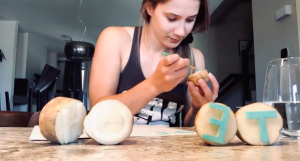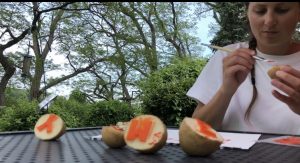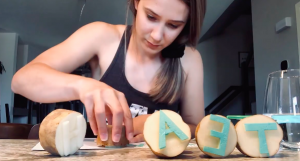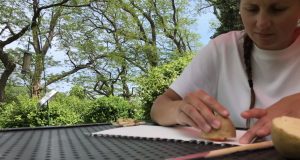My Post and part two of Katyln Paslawski’s post both use the medium of a time-lapse, a common feature on smartphones, to document our processes of making potato prints. This could be a result of us both being visual learners and wanting to include a quick overview of the process or be due to commonalities we may share as constructivist educators.
Our posts generate different user-experiences. In my blog, the time-lapse is embedded with youtube at the top of the post to catch the attention of the reader. This facilitates the ease of use to watch the video and after pressing play, the reader can continue scrolling or choose to watch for 36 seconds. This user-experience is used as a way to provoke interest in readers with a visual depiction of the process or the reader can be viewed as a consumer and the time-lapse offers a method to diversifying the content of text, video and image and maintain interest.
Katyln’s post provides the time-lapse as a downloadable link at the bottom of the page. By providing a link, it is likely that people who are interested in the creation process will download and view it. These extra steps may mean that only people who have read the entire post and remain interested in watching the video will follow through to download. The difference in user-experience can be seen as the time-lapse featuring as additional information or resources in an academic format to further clarify the reader’s understanding of the process.


Through the footage supplied, we had very similar experiences of carving letters and even used the same brand of paint. We are both focused on the task of potato printing throughout the entire video, evident by the concentration on our faces. The videos provide a blueprint of the process, as evidenced by these screenshots. The inclusion of time-lapse as a medium speaks to the fast-paced, information saturated, online consumer culture.
The use of this medium can relate to the capitalist view that ‘time is money’ and that it would be a waste on time to watch the entire video, so here is a sped up version.
 Additionally, the medium can appeal to the cultural phenomenon of addiction to keeping up to date on social media, specifically to consuming content without processing all of the information. This aligns with the common user experience of feeling a ‘fear of missing out’ despite not participating or engaging in any meaningful way with the author or content.
Additionally, the medium can appeal to the cultural phenomenon of addiction to keeping up to date on social media, specifically to consuming content without processing all of the information. This aligns with the common user experience of feeling a ‘fear of missing out’ despite not participating or engaging in any meaningful way with the author or content.
 Does including a time-lapse video in an academic blog qualify the medium as an appropriate source for documentation? Are we attempting to provide evidence for our process through the inclusion of a time-lapse video or are we appealing to a more capitalist market by creating an engaging product? Is there a way we can slow down?
Does including a time-lapse video in an academic blog qualify the medium as an appropriate source for documentation? Are we attempting to provide evidence for our process through the inclusion of a time-lapse video or are we appealing to a more capitalist market by creating an engaging product? Is there a way we can slow down?